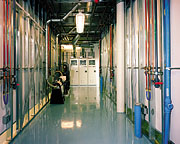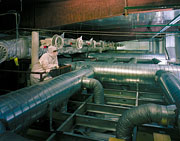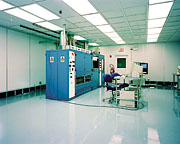
Here's a riddle for you: What happens when a high-tech company needs a Class 1,000 cleanroom built on a small budget and designed, constructed, and brought on-line in 14 weeks? Is your answer complete chaos? That might be the case in many instances, but that's definitely not what happened for this year's recipients ofEngineered Systems' Engineering Team Award.
The Team Award is given out each year to a group, including engineering/construction professionals and a facility owner, that best demonstrates how it can work together harmoniously in order to bring a project to fruition. This year, Engineered Systems felt that team spirit was best exemplified by those who designed and built the Alfalight Cleanroom Facility in Madison, WI.
This group of hard-working individuals had limited experience designing cleanrooms, but their dedication to getting the job done - and done correctly - helped them overcome any obstacles that blocked their path. The result is a cleanroom that was not only finished on time, it came in at half a million dollars under budget. And better still, almost a year after the project was finished, the cleanroom is working just great, and all team members have nothing but wonderful things to say about one another.

How The Team Came About
Alfalight is a high power diode laser manufacturer that is currently developing 980nm pumps for erbium-doped fiber amplifiers. The company was established in November 1998 to commercialize high power diode laser technologies that were developed at the Reed Center of Photonics, an engineering research center of the University of Wisconsin-Madison. These patented technologies are based upon the use of aluminum free active-region (ALFA) diode lasers and novel structures incorporating buried gratings and ridges.In early 2000, Alfalight decided the time was right to build a 10,000-sq-ft Class 1,000 cleanroom to manufacture its high power laser diodes. The company was already working with a design firm when Craig Cheney came on board. Now the director of processing for Alfalight, Cheney started asking some hard questions of the design firm, but he could never get a straight answer.
"Every time they came back with an answer it was either going to cost us another half million dollars or another million dollars," says Cheney. This design firm eventually gave them a final price tag of $4.5 to $5 million, which did not fit with the company's view of what a cleanroom should cost. The original design firm was dismissed in the last week of August 2000, and given that Alfalight wanted the cleanroom up and running by the last week of December 2000, Cheney had to find another design firm quickly.
Cheney turned to Carl Ruedebusch, president, Ruedebusch Development and Construction, Inc. (Madison), who knew of a building shell with a dirt floor that just might work for Alfalight. The company felt the shell would be perfect for its cleanroom and office space, and it decided to lease the space. Ruedebusch then helped assemble the team that designed and built the facility.
"Within a matter of a day-and-a-half, we assembled a whole new design and construction crew," says Cheney. Ruedebusch suggested that Durrant Group, Inc. (Madison) perform the mechanical and electrical design for the facility. (Durrant is a multidisciplined, multioffice, market-driven, client-focused, project delivery A/E firm whose motto is "Transcend the mundane by expanding the possible.") Durrant, in turn, suggested General Heating and Air Conditioning (Madison) as the mechanical contractor to do the material procurement and installation.
The team sat down in September and during four days of the initial design phase, Alfalight and Ruedebusch came up with a budget for the cleanroom of around $2.2 million. Then the project really started to take off.
Intense Design Work
With only 14 weeks left to deliver a working cleanroom, the team knuckled under and began hammering out a design. Alfalight had a strict set of parameters that it needed for its cleanroom. Those parameters included 0.5-micron particles/cubic foot of air; a constant temperature of 70 degrees F ± 1 degrees; relative humidity at 45% ± 5%; and static pressure at .04 in. ± .01 in. of water.Alfalight was very sensitive to first cost, but it also looked at building operation costs and ease of maintenance. To that end, the team spent 15-hour days to come up with a preliminary design. "We actually weren't completely done with the design phase when we started construction. We had a really good base level plan, but details were worked out on a day-by-day basis as we started construction," says Cheney. Even so, there were no changeorders required throughout the facility's design and construction.
David Nelsen, P.E., director of engineering, Ruedebusch Development, notes that the short design and planning stage was difficult. "This was the first cleanroom that Ruedebusch had done for a semiconductor facility. It was a challenge. It was a trial by fire situation. The schedule was extremely short, and we were hitting the ground running from a stand still. From our standpoint we just had to jump in with both feet and take off," says Nelsen.
Facilitating the experience, however, was Cheney, who had 20 years of experience in the semiconductor industry. "Craig always let us know from his position and from his understanding if things were going the way he was intending or envisioned. I think that was the key," says Kevin Lichtfuss, P.E., Durrant Group, Inc.
Nelsen adds, "Craig was a tremendous asset to the project. He was very familiar with systems that worked and had some very strong views of what he wanted to see in the system. He gave a lot of the guidance to help keep us on track, rather than spending a lot of time looking at systems that maybe weren't quite as appropriate."

System Details
Based on the team's experience, the final design was created. Cheney worked right along Durrant, General Heating and Air Conditioning, and Ruedebusch to ensure the system was what he had in mind. One of the first hurdles the team came across was determining the thermal calculations for the equipment and people: How many times did the air have to turn over in the cleanroom to maintain the cleanroom specification? How much heat went into the air vs. how much would go into the process cooling water loop? These questions were difficult to answer.But thanks to the team's expertise (and a lot of research), everything fell into place. The main equipment room, which is designed as a two-level concept, takes advantage of a 20-ft high ceiling while conserving floor space. A Carrier 50,000 cfm air-handling unit (AHU) was elevated with a full-length grated floor system to ensure accessibility of all components. The air handler has a cooling coil and a heating coil, as well as two stages of particle filtration. The air that hits the production floor is filtered five times by the time it gets there.
Two high-efficiency Fulton pulse combustion boilers, rated at 1.4 million Btu each, pumps, and an air compressor serving Walton Laboratories atomizing-type humidifiers were chosen for energy efficiency. Two outdoor Carrier 150-ton air-cooled chillers were selected for their year-round operability, ease of maintenance, and long-term energy efficiency and savings.
A chilled water system made the most sense, because it's easier to control, says Lichtfuss. "We had to select a system that would run in the cold Wisconsin winters. Technically you can get that with direct expansion systems, but they're not nearly as reliable. These outdoor air-cooled chillers are much more controllable. We had to maintain close temperature tolerance in the space, and we could modulate a valve much more precisely than banging compressors on and off."
The building's automation system by Carrier controls the hvac functions while monitoring other process piping systems and gases. The 50,000-cfm unit supplies a plenum space above the cleanrooms with 50 degrees HEPA filtered air. Secondary AHUs located in the plenum are accessible via a catwalk system and supply each cleanroom through ceiling-mounted HEPA filter diffusers.
One of the issues that arose concerned the piping that ran over the cleanroom space. Alfalight could not risk having the piping leak into the cleanroom, yet it was necessary to provide individual temperature control in each of these cleanroom suites. Fortunately, Durrant had the answer.
"The 50,000-cfm air handler supplied air to the plenum, then the individual air handlers took that air from the plenum and delivered it to the individual cleanrooms. Well, the problem with that is if you have more heat being produced in one cleanroom than the other, there's no adjustability, it's only one big zone. We didn't want to put chilled water coils in each one of those little air handlers supplying each cleanroom," says Lichtfuss.
So what Durrant did was duct some of the main air, at 50 degrees, from the main air handler through dampered branch ducts that terminate into the back end of each one of the nine smaller air handlers. If a cleanroom got too warm, individual thermostats in the cleanrooms would open up the damper and inject raw 50 degree air from the primary system to meet the load. Thus, it became an air-based system.
Special Systems
A semiconductor cleanroom houses all sorts of toxic chemicals and gases. As such, life safety is a key consideration. Hydrogen is one of the elements used at Alfalight, so an emergency ventilation system had to be designed. The system has five hydrogen sensors in the cleanroom spaces, so in the event hydrogen is detected within the cleanroom envelope, a huge ventilation fan pulls all the hydrogen through a vent. "Although we'd lose the cleanroom envelope at that point in time, it's much more important to vent out the hydrogen than it is to maintain the cleanroom envelope at [that point]" notes Cheney.Lichtfuss adds that the monitoring sensors are throughout the plenum and evacuation systems, so if any toxic gases leak out, they're exhausted from the space. "The emergency ventilation system was probably one of the few known, completely understood facts going into the project," he notes.
Alfalight also had extensive exhaust requirements, because certain processes result in fumes that have to be vented. An uninterruptible power supply for the exhaust fans ensures that the exhaust system will always work. The exhaust system provided some challenges to Durrant, as when construction started, Alfalight didn't have its equipment selected.
"A lot of their equipment required exhaust, but they didn't have it selected, they just knew that there would be some exhaust needs for these pieces of equipment in these general areas. We ended up selecting a nominal fan size, putting in four of the same size, and locating them strategically over the area. As they selected the equipment and located them, we ducted them appropriately to fit the fans," says Lichtfuss.
In addition, the extremely expensive and temperamental equipment in the cleanrooms requires process cooling water. Cheney, himself, developed and installed a closed loop process cooling water system. Lichtfuss admires Cheney's ability to do it himself and would like to use Cheney for future jobs that require process piping.

Constant Communication A Must
Given the scope of this project, it is truly amazing that it was completed in only 14 weeks. Normally this type of project is several months in programming and planning, several months in design, and a year or more in construction. That's the way it's always been done and it ensures that when a project is done, it most closely meets the owner's needs, because nothing has been skipped in the process."With this project, we were designing things when we didn't even know what some of the equipment was that would be put in the space. We had to build in all these flexibility and safety factors, without inflating the cost of the project," says Lichtfuss.
In fact, the time frame was the biggest challenge for all members of the team. Lichtfuss notes that almost everything that was complex was either caused by or heightened by the delivery schedule. "I think that all the team players, including right up to the top, knew that we potentially had something here, and if you wanted to continue with the team, everybody had to perform, including the equipment vendor. I don't care if he had to go to Timbuktu to find a chiller sitting in somebody's yard. It had to be there on time."
Cheney says weekly meetings were one of the ways in which the team stayed informed throughout the project. "One of the keys to us being successful in coming in on time and under budget was the fact that we had weekly construction/design meetings that involved all the key players. We'd sit down in a room once a week and the meeting got done when we got all the problems worked out so we could guarantee that construction could continue for the next week without any problems," says Cheney.
He adds that all team players were open and willing to communicate on a one-on-one basis without holding any grudges against anybody else. "I realized that the quicker you sit everybody down and start talking about things [the better], rather than letting hard feelings become a factor that contributes to the demise rather than the success of a project."
Nelsen agrees that the success of the project was due to communication. "For me, the weekly meetings were not the most crucial things. It was the daily contact. This project went so quickly and had so much complication to it in terms of a normal project that we had daily contact in terms of a team. The meetings were a summation of what we got done this week and here's where we're going next week, but it was the daily communication that was more important," he says.
"We had to be constantly communicating. The weekly meetings were important because you got all the players around the table at the same time. Other communication that happened daily occurred between two players at a time, which was also important. Everybody knew it wasn't possible to just go off and do something solo, because that affected everyone else. We had no Lone Rangers out there," says Lichtfuss.
Due to the experienced team members and the extensive communications that took place, Cheney notes that the control system, chillers, air handlers, boilers, pumps, everything came on-line exactly as designed. "It was 14 weeks from start to finish, and we had the cleanroom up and running on December 28, 2000. Since then we haven't had any problems."
As for the rest of the team, they're sticking together. Durrant, Ruedebusch, and General Heating and Air Conditioning are currently finishing up a biotechnical facility that also has cleanrooms and a BSL 3 level suite. And, again, it's on a short time schedule, but it will be completed on time.
Given how well this group works together, don't be surprised if this crack team of engineering and construction professionals turns up in your town in the near future. ES

